Goals
-
Learning advanced techniques to help you create more concise circuits within Logisim.
-
Feel free to do each part as separate sub-circuits in the same Logisim file.
-
Strengthening experience in designing circuits using Logisim.
Lab 6
Computer Architecture I @ ShanghaiTech University
Advanced Logisim
Download the files for Lab 6 first.
Here are three Logisim features that should both save you a lot of time and make your circuits look much cleaner.
1. Splitters
Splitters allow you to take a multi-bit value and split it up into smaller parts, or (despite the name) combine multiple values that are one or more bits into a single value.
Here, we split the 4-bit binary number 0111 into 01 and 11, then recombine it with 10 into the final 6-bit number 100111:
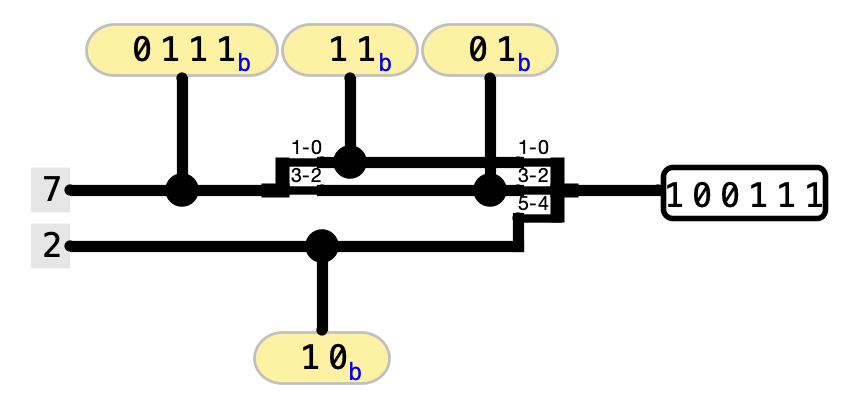
Click on a splitter to get its menu in the sidebar. This menu determine the number of arms on your splitter and how many bits should go on each arm. For the circuit above, the left splitter's menu looks like this:
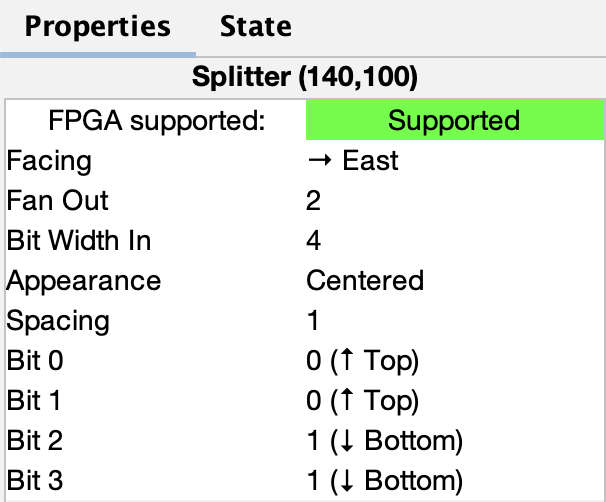
While the right splitter's menu looks like this:
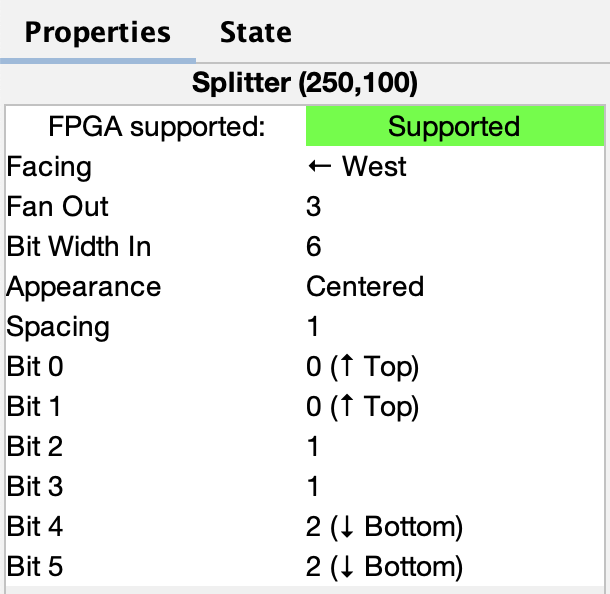
Notice that there's an option called facing. You can use this to rotate your splitter. Above, see that the splitter on the right is facing West while the splitter on the left is facing East.
If you see an error wire that is orange, this means that your bit width in does not match your bit width out. Make sure that if you're connecting two components with a wire, you correctly set the bit width in that component's menu.

2. Tunnels
A tunnel allows you draw an "invisible wire" to bind two points together. Tunnels are grouped by case-sensitive labels give to a wire. They are used to connect wires like so:
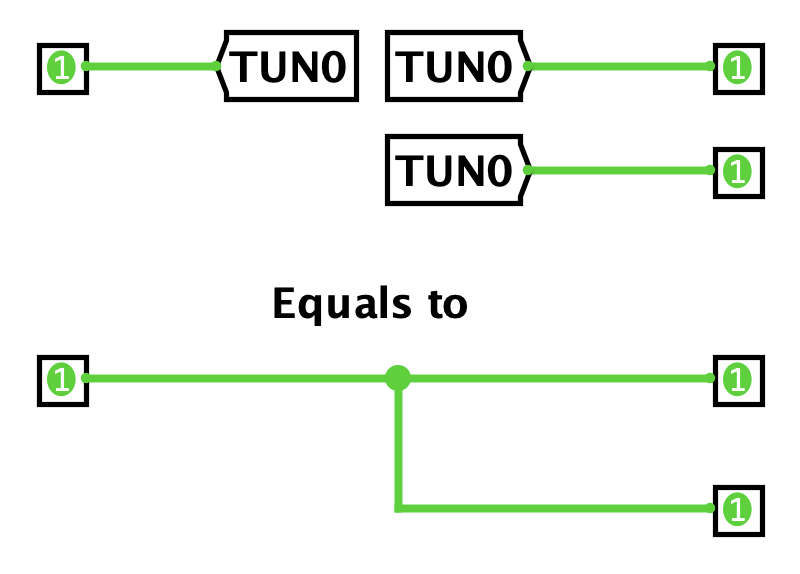
Some care should be taken as to which wires are connected with tunnels to which other wires, such as in this case:
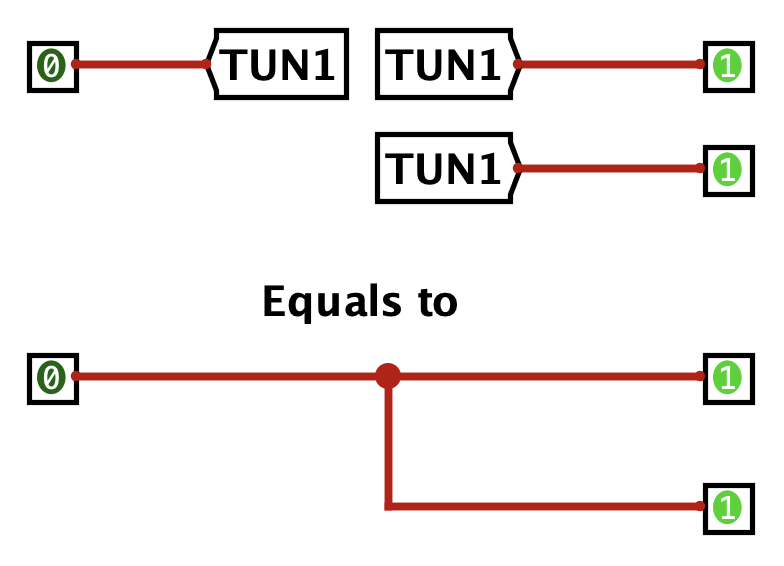
We strongly recommend you use tunnels with Logisim, because they make your circuits much cleaner looking, and therefore easier to debug.
3. Extenders
When changing the width of a wire, you should use a bit extender for clarity. For example, consider the following implementation of extending an 8-bit wire into a 16-bit wire:
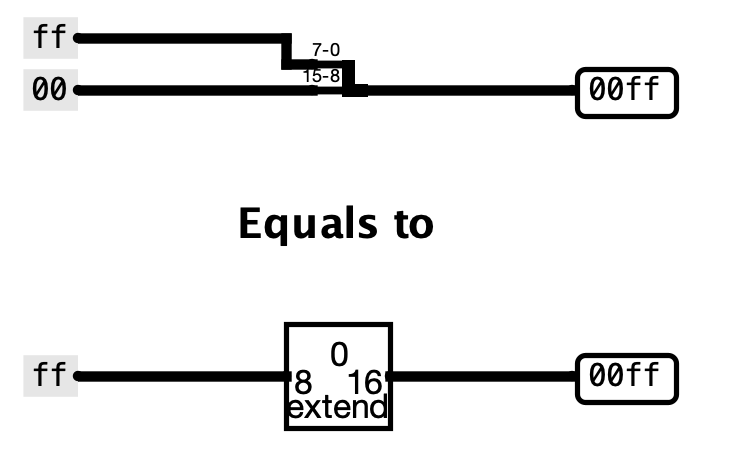
Compared to the splitter, the extender is easier to understand at a glance. This becomes especially helpful when working with complex circuits.
Additionally, consider the case of throwing out bits. Despite its name, an extender can also perform this operation:
Exercises
Exercise 1: Practice with Advanced features
In this part of the lab, we will construct a circuit that manipulates an 8-bit number.
ACTION ITEM:
Complete the following steps to create the splitter circuit, and show this to your TA (remember to save). When you've completed the circuit, answer the question in the checkoff session.
-
Open up the Exercise 1 schematic (
File->Open->ex1.circ) and go to the empty Split circuit. -
Go to the
Wiringfolder and select theSplittercircuit. This circuit will take a wire and split it into a set of wires of smaller width. Conversely, it can also take many sets of wires and combine them into one. -
Change the
Bit Width Inproperty (bus width) to8, andFan Outproperty to8. Connect the inputs to tunnels -
Now, judge the number of '1s' in the input whether odd. You can use
XORgates to eath bit of input and route the output toOUT1. -
Then, judge the number of '1s' in the input whether greater than '0s'. You can use
Bit Adder and ComparatorfromArithmeticto implement this circuit and route the output toOUT2. -
We need to add a parity bit to the input to ensure that output has odd number of '1s', you are not allowed to use parity circuits from logisim
Gates. Place another splitter with the proper properties to combine the parity bit and the input toOUT3. -
We consider the
OUT2is the sign bit of input, changing input into 2's complement format. Place another splitter with the proper properties to combine the sign bit and the 2's complement toOUT4.
Hint 1: An unsigned comparator is required in OUT2.
Hint 2: The parity bit can be obtained from OUT1 because when input has odd bit '1s', the parity bit will be 0, otherwise, the parity bit will be 1.
Hint 3: 2's complement transform is different according to sign bit.
- Show your
ex1.circto your TA. - When the output from
OUT4is negative and we want to compute its two's complement once more, what would the outcome be? Hint: In fact, this is a question about finding the two's complement of a two's complement. Just share your findings with TA.
Exercise 2: Rotate Right
With your knowledge and experience of splitters and multiplexers, you are ready to implement a non-trivial combinational logic block: rotr, which stands for "Rotate Right". The idea is that rotr A,B will "rotate" the bit pattern of input A to the right by B bits. So, if A were 0b1011010101110011 and B were 0b0101 (5 in decimal), the output of the block would be 0b1001110110101011. Notice that the rightmost 5 bits were rotated off the right end of the value and back onto the left end. In RTL, the operation would be something like R = A >> B | A << (16 - B).
ACTION ITEM:
Implement a subcircuit named rotr with the following inputs. Show the final circuit to your TA (remember to save!).
A(16-bit), the 16-bit input to be rotatedB(4-bit), the rotation amount (why 4 bits?) You can find the starter subcircuit inex2.circ.
The output should be A rotated right by B bit positions, as outlined above. You are NOT allowed to use Logisim shifters in your solution, though all other combinational logic (MUXes, constants, gates, adders, etc.) is allowed. Logisim's built-in MUXes (find them under the Plexers menu) might be especialy helpful. Your solution shouldn't involve a clock or any clocked elements, like registers.
Hint 1: Before you start wiring, you should think very carefully about how you might decompose this problem into smaller ones and join them together. You should feel very free to use subcircuits when implementing rot4 and rot8 as well as rotr.
Hint 2: Just because we gave you an RTL representation doesn't mean it's the best way to look at this problem. Think about the input bits of B and think about how to effectively use splitters! Can you do something with the binary form? Remember why binary is good for use in computers: a 1 is easy to represent as an ON signal, and a 0 is easy to represent as an OFF signal. Let's say we want to rotate 11 times. 11 is 1011 in binary, or 1*8 + 0*4 + 1*2 + 1*1. Can you use this to make a cleaner circuit? Making use of the rot*circuits we have provided is a good idea that will keep things clean!
Hint 3: Perhaps you also need to create other sub-circuits and call them in the rotr circuit. Please explore how to customize the appearance of your components! It's important to note that after designing their appearance, they also need to be saved immediately and their Appearance attribute should be changed to Custom.
- Show your TA your
rotrcircuit and verify that it works.
Exercise 3: Runing LED
From Exercise 2, we obtained a combinational circuits which can rotate the input with different values. In this part of lab, we will implement a version for sequential circuits. For each clock, the input will rotate with step of 1 and the rotated value will be input next time. For example, if input is 0b10000000 and we set the rotate step of 1. At clock 2, output is 0b01000000, at clock 3, output is 0b00100000...
ACTION ITEM:
Complete the following steps and show this completed circuit to your TA (remember to save!)
-
Open up the Exercise 3 schematic (
File->Open->ex3.circ) and fill in therot1, you can use the circuits in Exercise 2 and revise the width of input and output. -
Using the
Registerto store the previous value, and then using arot1to rotate the value, the output isOUT_LED. -
Using a
Multiplexerto set the initinal valueINITIAL_LEDofRegisterwhen reset signalRSTis 1. WhenRSTis 0, the input of Multiplexer will beOUT_LED.
- Show your TA your
Runing LEDcircuit and verify that it works. - If we want to control the LED to shift for a certain number of times, such that it stops after moving 8 times, remaining stationary until the next change in the
RSTsignal occurs. What changes should we make to the circuit? Show your TA your revised circuit drawing or create a new Logisim file containing your revised circuit.
Testing
Debugging circuits can be done in two ways. One method involves directly using the poke tool to alter component values and observe the output instantly. The second approach is to use the testing scripts provided by us via:
./test.sh
Since Logisim will be running in one terminal window already, make sure to open up a new window to run the testing script.
If it says you don't have permission to test.sh, run the following code:
chmod +x test.sh
If it says you don't have permission to test.py, run the following code in the ./testing folder:
chmod +x test.py
The following TA(s) are responsible for this lab:
Zhaojun Ni